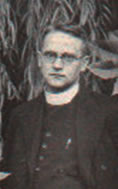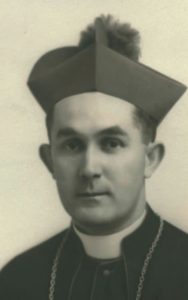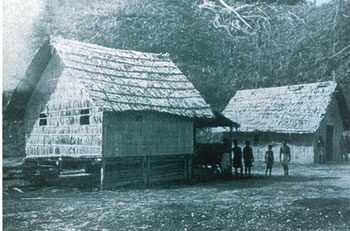Fr Wilhelm Weber sm
by Fr Joseph Lamarre sm with acknowledgment to Lindsay Riddick
Tunuru 1939-45. Part Two
Sometime later, the people saw a Japanese wearing Father’s watch. Others were seen with clothes that had been in his bags, some found the Mass vestments from the mass Kit torn to shreds. Then one day a Japanese appeared at Bove, close to the village of Tarar, with Father’s Breviary from which he tore out pages to roll his cigarettes. The people report that the day after his arrival at Bove, the Japanese collapsed and died. By that time there was not the least doubt in the mind of the people that Father Weber had been killed.
August 1945 saw the end of the war. As soon as the Japanese were gone from the surroundings, the people decided to investigate. Joachim Mateagu and Tomuai, the faithful Catechist of Bove, went with a small party to the spot where they had last seen Father. From there they visited all the small camps of the Japanese and found the Headquarters. The jungle growth was reclaiming the ground, the Japanese makeshift houses were falling to ruin and close to one group of houses they found a cemetery, and then a few yards from the cemetery, a lonely grave, close to a large tree. (A canoe tree, for the people use them to make their canoes). That was it. The people dug and at about the depth of two feet, they found the body in an advanced state of decomposition, the head resting on the chest. They recognised Father by his hair, his glasses, clothes. shoes and his Rosary. Even his walking stick had been thrown into the grave. There was not the least doubt in the mind of the people that they had discovered the body of Father Weber. They covered the remains with a sheet of corrugated iron from a nearby camp and reburied him.
The Japanese veterans insist Fr Weber was shot, not beheaded. Mr. Yokoyama and Mr. Kimura were eye-witnesses. Their story is as follows: ‘The officer told Fr. Weber that they had to execute him. Then when Fr. Weber asked what was the reason for his execution, he was told by the officer that they had received the order and that they had to obey. Then Father asked to give him time to pray1. He continued his prayer for a while and then was told: ‘It is time now to be executed’. He was shot in the back of the head and died instantly. His body was buried with respect at a Japanese graveyard and a cross erected on his grave and flowers were put there by Japanese soldiers. This far the story of the eye-witnesses.
The Missionaries returned to the East Coast of Bougainville in June 1946. Father Muller was appointed to Tunuru. The people who had been without a priest for so long, immediately rose to the occasion and rebuilt their churches and village chapels. Now was the time for them to fulfil their duties towards Father Weber. A group of people, headed by Joachim Mateagu, the faithful Catechist Tomuai, the Catechist Paul Uwa and others returned to the grave, exhumed the remains, placed them in a Japanese ammunition box and brought them to Tarara. There they placed the box under the alter in their little village chapel. A delegation was sent to notify Father Muller at Tunuru. There with all the prayers of the Church, the remains of the valiant and zealous Missionary were buried in July 1946. Fr Weber’s bones rest a short distance from where he worked so well for so many Catholic people.
Since the main concentration of Japanese troops was at Arigua, it was always said that Father Weber was executed and buried at the back of Arigua. Mabiri did not count in those days.
A few years after the war, the Mabiri plantation was bought by Bishop Wade. For some years Mabiri was the site of the Novitiate of the B.S.J. brothers. For the past two years the buildings of the native brothers have been occupied by the Catechist Trainees while waiting for their own building to be completed.
Having known Father Weber well and having been his neighbour for two years, 2
I got interested in the site of his execution. During the month of September 1965, I questioned William and Joachim about the spot “in the back of Arigua” Plantation. They emphatically denied that it was in the back of Arigua. They claimed it was on the Mabiri property, close to the Kuriwana boundary. Brother Patrick and I obtained all the information necessary before starting the search.
So it was twenty years later, on the 3rd of October 1965 that Brother Patrick with Joachim and William, some Catechist Trainees and other people went out in search of the grave. The jungle had grown, the roads had disappeared, a part of the ground had been cleared for a new coconut plantation. But the two small rivers had not changed; they were the guide- posts. First Brother and the people located the large “Canoe Tree”, the debris of the Japanese camp, then the little Japanese cemetery, and finally the open grave from which they had removed the remains of Father Weber. All recited prayers for the repose of his soul and returned.
The following day a larger party of people from Tarara, with the Catechist Paul Uwa, together with the catechist trainees, accompanied me and Brother Patrick to the site. The trainees cleared the spot, and there was the open grave and the place of execution of a real Marist Missionary. Close to the grave was the sheet of corrugated iron that had covered his body. Prayers were said for this Marist Priest who sacrificed his life rather than abandon his flock.
The Brothers of St Joseph have since placed a large cement slab over the grave and a large white cross has been erected bearing Father’s name. Soon a brass plate will be placed on the grave with the proper inscription. This hallowed spot is only half a mile through the bush from the buildings being erected for the new catechist School. Father Weber’s bones were removed to Tunuru, but his flesh decayed in a lonely spot near the Barurubiri river on Mabiri. The Catechist Trainees have adopted this place as a revered grave that they must keep and cherish as befits the ground that has drunk the blood of a true priest of God. 3
Since then a hall at Mabiri Ministri Skulhas been donated by the Kagawa- Bougainville Association and the Japan- Solomon Association in honor of Fr Weber. The hall was blessed and opened on Wednesday 4th August 2004 in a ceremony attended by representatives of both Associations, the Japanese Consul General, government officials, church personnel and people from the area. Also a Reconciliation ceremony for healing of memories was held.
A side chapel has been established in honour of Fr Weber in his home town of Gelsenkirchen.
Footnotes:
1 Bartholomew Mekaa of Tapiang told me that Fr Weber had been carrying a letter from the American Army passed to him by Fr Lebel. At Japanese HQ he had gone to the toilet and dropped the letter in an attempt to destroy it. This was subsequently found by Japanese soldiers and passed on to their Captain who realised he had had contact with the Americans and this was the reason for the execution.
2 The Rivers have since moved and this block and cross has since been washed away - 2012.
3 This paragraph appears to have been added later than the rest of the Lemarre document.



 Entries(RSS)
Entries(RSS)